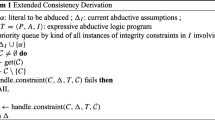Abstract
Imperfect information is a very general term that comprises different types of information, such as uncertain, vague, fuzzy, inconsistent, possibilistic, probabilistic, partially or totally incomplete information [2]. In the literature of knowledge representation we find a different formal model for each one of these distinct types. For example, annotated logic is a formal model to represent inconsistent information.
Annotated logics are non-classical logics introduced in [20] as a logic programming theory. They were proved to be paraconsistent. Based on [5], we present in this work the annotated logic programming theory and some of its applications in Artificial Intelligence (AI). We present it as a formalism to reason with inconsistent information and investigate its possibility to represent other types of imperfect information, such as possibilistic and non-monotonic reasoning. Our main goal is to verify and confirm the importance of annotated logics as a tool for developing knowledge-based and automated reasoning systems in AI.
Similar content being viewed by others
References
J. M. Abe. Fundamentos da Lógica Anotada (Foundations of Annotated Logic) - in portuguese. PhD thesis, Universidade de São Paulo, 1992.
G. Bittencourt. Inteligência Artificial: Ferramentas e Teorias. 10a. Escola de Computaão, 1996.
H. A. Blair and V. S. Subrahmanian. Paraconsistent Foundations for Logic Programming. The Journal of Non-Classical Logic, 5(2), November 1988.
H. A. Blair and V. S. Subrahmanian. Paraconsistent Logic Programming. Theoretical Computer Science, 68:135- 154, 1989.
D. V. Carbogim. Programaão em Lógica Anotada: Teoria e Aplicaões. Master's thesis, Instituto de Matemática e Estatística da Universidade de São Paulo, 1996.
F. S. Corrêa da Silva. On Reasoning With and Reasoning About Uncertainty in AI. In European Summer Meeting of the Association for Symbolic Logic (abstract published in The Bulletin of Symbolic Logic, v. 3(2):255–256), Spain, 1996.
N. C. A. da Costa, J. M. Abe, and V. S. Subrahmanian. Remarks on Annotated Logic. Zeitschr. f. Math. Logik und Grundlagen d. Math., 37:561- 570, 1991.
N. C. A. da Costa, V. S. Subrahmanian, and C. Vago. The Paraconsistent Logics Pτ. Zeitschr. f. Math. Logik und Grundlagen d. Math., 37:139- 148, 1991.
D. Dubois and H. Prade. Necessity Measures and the Resolution Principle. Technical Report 267, LSI-Universite Paul Sabatier, 1987.
M. Fitting. Bilattices and the Semantics of Logic Programming. The Journal of Logic Programming, 11:91- 116, 1991.
M. Kifer and E. L. Lozinskii. A Logic for Reasoning with Inconsistency. Journal of Automated Reasoning, 9:179- 215, 1992.
M. Kifer and V. S. Subrahmanian. On the Expressive Power of Annotated Logic Programs. In NACLP'89-Proceedings of the 1989 North American Conference on Logic Programming, 1989.
M. Kifer and V. S. Subrahmanian. Theory of Generalized Annotated Logic Programs and its Applications. Journal of Logic Programming, 12:335- 367, 1992.
M. Kifer and J. Wu. A Logic for Programming with Complex Objects. Journal of Computer and System Sciences, 47:77- 120, 1993.
S. M. Leach and J. J. Lu. Query Processing in Annotated Logic Programming: Theory and Implementation. Journal of Intelligent Information Systems, pages 1- 28, 1995.
J. J. Lu, L. J. Henschen, V. S. Subrahmanian, and N. C. A. da Costa. Reasoning in Paraconsistent Logics. In R. Boyer, editor, Automated Reasoning: Essays in Honor of Woody Bledsoe, pages 181- 210. Kluwer Academic, 1991.
J. J. Lu, A. Nerode, J. Remmel, and V. S. Subrahmanian. Towards a Theory of Hybrid Knowledge Bases.
R.T. Ngand V. S. Subrahmanian. Probabilistic Logic Programming. Technical report, University of Maryland-Department of Computer Science, 1989.
R. Reiter. A Logic for Default Reasoning. Artificial Intelligence, 13:81- 132, 1980.
V. S. Subrahmanian. On the Semantics of Quantitative Logic Programs. In Proc. 4th IEEE Symposium on Logic Programming, pages 173- 182, San Francisco, September 1987.
V. S. Subrahmanian. Amalgamating Knowledge Bases. ACM Transactions on Database Systems, 19(2):291- 331, 1994.
K. Thirunarayan. On the Relationship between Annotated Logic Programs and Nonmonotonic Formalisms. J. Expt. Theor. Artif. Intell., 7:391- 406, 1995.
M. H. van Emden. Quantitative Deduction and its Fixpoint Theory. Journal of Logic Programming, 1:37- 53, 1986.
Author information
Authors and Affiliations
Rights and permissions
About this article
Cite this article
Carbogim, D.V., da Silva, F.S.C. Annotated Logic Applications for Imperfect Information. Applied Intelligence 9, 163–172 (1998). https://doi.org/10.1023/A:1008268003741
Issue Date:
DOI: https://doi.org/10.1023/A:1008268003741




